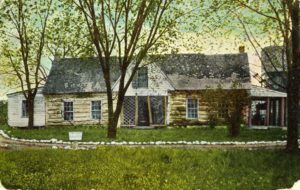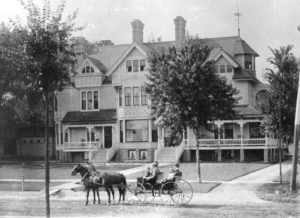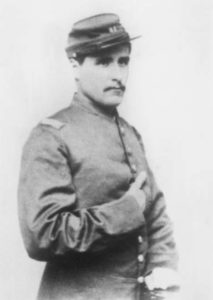A pocket-sized history of local street names
What’s in a name? When it comes to our streets, apparently a lot. Street names are often a window to the past. In the Fox Cities, they run the gamut from the surname of a local inventor to a Native American greeting. Some streets were named based on their proximity to geographical features such as the Fox River. Others were named with the sole purpose of flattering potential Lawrence University donors. What follows are several streets with names that reveal a bit about our dynamic past.
College Avenue, Durkee, Lawrence and Morrison Streets
The first streets built in Appleton were those surrounding the location of the original Lawrence Institute, located where the future Gabriel Lofts and current Downtown YMCA are today. In 1848 Methodist church leaders William Sampson, Reeder Smith, Henry Blood and Joel S. Wright, a surveyor, moved to the Lawrence Institute property and set out the survey and plat. The academy block was surrounded by College, Durkee, Morrison and Lawrence named for donors. Durkee Street was named for Charles Durkee, an early donor to the Lawrence institute. Morrison Street was named for Arch M. Morrison who donated $500. Lawrence Street was named for Amos Lawrence, who in 1846 pledged $10,000 if the Methodists could match it with $10,000 of their own. College Avenue was named for the “University in the woods.”
Doty Avenue

This Neenah avenue was named for the second territorial governor of Wisconsin, James Doty. Doty, who was also a judge, congressman and land speculator, first visited the area on a surveying expedition in 1820. He later built his retirement home, known as the Grand Loggery, on Doty Island in 1845. The street is located one block south and parallel to Wisconsin Avenue. The 1879 map shows Doty Street for what is now Doty Avenue.
Ballard Road
Anson Ballard was an early lawyer who came to Appleton in the 1850s from New York and remained here until his death in 1873. He practiced law for several years and later went into the real estate business. Ballard was a prominent member of the Congregational Church in Appleton. His two brothers, Porter and Jesse, relocated with him. They and their families established farms along what is today Ballard Road. The street was named after the family because so many of them lived and work in the area.
Stevens Street

John Stevens was a Neenah flour miller who operated the Falcon Flouring Mills with his partner J. L. Clement. Stevens perfected the steel roller process for milling wheat and in 1880, he patented this process which produced a higher quality flour. The following year Stevens sold his patent rights to Charles Pillsbury of Minneapolis for $1 million and retired at the age of 40. He built the largest home on Wisconsin Avenue which was located on the corner of Wisconsin and Pine. In 1894, he commissioned the construction of a 98-foot steam yacht, The Cambria, which he moored in the harbor across the street from his house. Stevens Street, located just behind the Wisconsin Avenue mansion, was named sometime between 1900 and 1906 probably due to the proximity of it to Stevens’s home – it had previously been named Second Street.
Clovis Avenue and Grove Street
Melissa Handler was an immigrant from Vienna, Austria. After moving to Menasha, she married John Clovis in April of 1870. They had four children – Ida, Arthur and two sons who died in infancy. The Clovis family purchased land in the northwest corner of Menasha. In 1896, Ida Clovis married Frank Grove. They were a hardworking and successful couple who owned a large dairy farm on the family land. Ida and Frank had three sons – Alva, Vernon and Harold. Alva, who was the only son who remained in Menasha, inherited the farmland and eventually donated the land to the City of Menasha in honor of his grandmother, Melissa Clovis, and his mother, Ida Grove. Clovis Grove Elementary School was built on the land in 1958. Streets in the neighborhood around the school are named for members of the Clovis and Grove families. These include Alva, Ida, Melissa, Arthur, Grove, John and Visgro Streets and Clovis Avenue.
Pendleton Road
Peter Pendleton is believed to be part of the Stockbridge Tribe of Mohican Indians who had been forced from their homes in New York. He was one of Neenah’s earliest settlers, arriving sometime between 1828 and 1831. Peter and his wife Sally had 17 children and farmed for many years in Neenah. Their son Jerome Pendleton was killed in service during the Civil War in 1863 in a battle in southern Indiana. He was in Company I of the 21st Wisconsin Infantry, the same Company in which Charles Clark served. Jerome is buried at Oak Hill Cemetery. Pendleton owned farm land near where the street is located on Neenah’s west side adjacent to Memorial Park and also south of Breezewood in the Whitetail Meadows subdivision.
Paris Street
Menasha’s Paris Street wasn’t always known by this name. Its original name was Berlin Street, but was renamed during World War I to disassociate from any German connection. This small street connects to the south of Broad Street along the Menasha Channel.
Dieckhoff Street
 Named for Douglas Dieckhoff (Signalman 1st Class), this street is located off of Oak Street in Neenah, south of Laudan Boulevard. Dieckhoff was born in 1919 and was the first service person from Neenah to be killed in WWII. He was one of 58 men killed aboard the USS Utah on December 7, 1941 when Japan attacked Pearl Harbor. The American Legion post in Neenah changed its name from Hawley Post to Hawley-Dieckhoff Post in his honor (James Hawley was the first man from Neenah killed in service to the country in 1918.) The street had been named Dieckhoff Street by 1950.
Named for Douglas Dieckhoff (Signalman 1st Class), this street is located off of Oak Street in Neenah, south of Laudan Boulevard. Dieckhoff was born in 1919 and was the first service person from Neenah to be killed in WWII. He was one of 58 men killed aboard the USS Utah on December 7, 1941 when Japan attacked Pearl Harbor. The American Legion post in Neenah changed its name from Hawley Post to Hawley-Dieckhoff Post in his honor (James Hawley was the first man from Neenah killed in service to the country in 1918.) The street had been named Dieckhoff Street by 1950.

Clark Street
Located on Doty Island in Neenah, this street was named for Charles B. Clark, one of the four founders of Kimberly-Clark which formed in 1872. An 1879 map includes the street name, making it one of the earliest named for an individual. Clark was also mayor of Neenah from 1880 to 1882, a Wisconsin State Representative in 1885 and was elected to U.S. Congress in 1886 to 1890 (he died in March of 1891). C.B. Clark, whose daughter was Theda, owned land at this site and in 1906 Theda Clark Memorial Hospital was built adjacent to Clark Street.
Circle Street
Erb Park neighborhood’s Circle Street used to be spelled “Cirkel.” It was named for William Cirkel who owned the tract of land through which the street runs. An Appleton native, Cirkel was active in civic affairs and served as a first ward alderman. Over time, the spelling was changed for ease.
East Kimball Street/Kimball Alley
Eliza Pierce Kimball and her husband Reeder Smith were both Appleton pioneers. Reeder worked closely with Amos Lawrence in the founding of Lawrence University, but Eliza was pivotal in the decision to come to Appleton and build the university in the first place. It was largely through Kimball’s efforts that the First Congregational Church was organized. East Kimball Street is being lost as a result of the bluff site redevelopment making way for U.S. Venture’s corporate headquarters. However, Kimball’s name will be honored as Kimball Alley, which had previously been one of Appleton’s 21 unnamed alleys.
Spencer Street
Appleton’s Spencer street was named for Elihu Spencer, a school master, farmer, surveyor and community leader. He bought a farm in 1852 fronting present day Spencer Street. As a history-minded individual, Spencer maintained detailed records of his time in Appleton. He kept a journal and preserved family heirlooms and letters. He was the secretary for the Outagamie County Pioneer Association which gave rise to the Outagamie County Historical Society and is now known as The History Museum at the Castle.
Lost in Translation
The earliest known residents of Wisconsin were the Menominee Indians. The name Menasha means “Little Island” in the Menominee language. Many streets in Menasha have been changed from the Menominee language to English. Some of the changes approved by the City Council on September 2, 1886 were:
- Penaysee Street changed to Oak Street
- Keshaynie Street to Nassau Street
- Neaht Street to Walnut Street
- Nahmut Street changed to Naymut, which means “welcome” in Menominee.
Special thanks to Jane Lang of the Neenah Historical Society, Gwen Sargeant of the Appleton Historical Society, Dustin Mack of The History Museum at the Castle and Kathy Humski of the Menasha Historical Society for contributing to this story.

